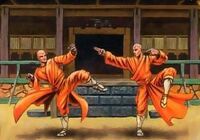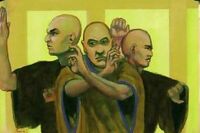| Please note: This article is about the temple in the Plains of Thunder. For other uses of the term, please see Temple of Osano-Wo (disambiguation). |

Temple of Osano-Wo (A14)
The Temple of Osano-Wo (A14) was the most martial of the monastic orders of the Brotherhood of Shinsei, revering both the mortal life and the divine power of Hida Osano-Wo, the son of the Kami Hida, Crab Clan Champion and Fortune of Fire and Thunder following his death.
Building[]
The temple itself was built from limestone gathered from the surrounding plain, and looked as much like a fort as a temple. [1] The temple was constantly surrounded by thunderstorms which encouraged the local vegetation to become green and lush, and the area was humid even in dry seasons. The land itself was rocky and difficult to traverse, moss covering the rocky landscape. [2] Lightning rods constructed by the Kaiu family dotted the temple's rooftop. At the front of the temple stood a large maze built out of limestone, [3] filled with hazards such as geysers and fields of sharp stones, a training ground for the monks. [1] The monk reserved quarters for the Emerald Champion, whom they viewed as one of Osano-Wo's chosen. [4]
Sohei[]

Sohei training at Temple of Osano-Wo
The Order of Osano-Wo was based primarily in the lands between the Scorpion and Crab Clans. [5] The first Temple of Osano-Wo was the birthplace of sohei, who trained as warriors. Some looked upon the order with suspicion because of this, but no one could deny that Osano-Wo was indeed blessed by the heavens. Though they operated many temples the largest was the first one created in the Empire, which was located on the Plain of Thunder near Shinomen Mori. It was founded by a retired Crab, [6] by the name Umaso, [7] and while all the clans had representatives among the retirees the majority had always been Crab. Monks of the order were more worldly than other monks, and often had a keen interest in the outside world. [6]
School[]

Brothers of Thunder
The primary teachings and devotion of the Temple of Osano-Wo were the Fortunes, but things such as battle, juijutsu and other bugei skills were also taught. [8] All monasteries of this order included small shrines to Bishamon, the Fortune of Strength. [9] They favored the ono, a weapon invented by them. [10] Those brothers who had reached the most advanced levels of martial training were called Thunder Sohei. They had hardened their bodies and trained their minds to a tremendous level of martial prowess. [11] A large maze surrounded the monastery's main entrance and made it impossible to access unless one knew the proper routes. After ten years spent in training, their final test was to find their way through the maze and exited through the temple's front gates. [12]
Known Techniques[]
Tradition[]
The sohei believed that enlightenment and mastery of the art of war were by no means mutually exclusive. [13] In terms of belief, the Order of Osano-wo was a typical Fortunist sect, seeking enlightenment through the Fortunes (specifically Osano-wo). In their method, however, they were like almost no others. The Order of Osano-wo was the most militant of the sohei orders, maintaining a large private army of monks in their great Temple of Thunder. They were credited with the invention of several weapons, not the least of which are the ono and nagamaki. His members were easy to identify, as all monks underwent ritual scarification and mortification, covering themselves in elaborate wraps and scarves. [14] [15] The scars were believed to ward off evil spirits. [16] The teachers gave prospective students new names, because their former lives, held no meaning there. Even criminals who passed the trials were regarded as one who had been reborn in Osano-Wo's flames. A magistrate could expect the entire order to stand against him, violently if need be, before they allowed one of their number to be taken away. [12]
Sensei[]
The Master Sensei was chosen by a vote among the monks. Once a lender was chosen, he must stay at the temple until their death. He must ensure the students were trained properly and to keep an ear open forth wishes of Osano-Wo. [12]
Known Sensei[]
Notable Students[]
Known Technique[]
- The Hand of Thunder
History[]
Founding[]
The temple was founded in 297, two hundred years to the day after Hida Osano-Wo's death. In their origins the monks of this temple maintained an identity separate from the Brotherhood of Shinsei, but keeping a close alliance with the Brotherhood. [17] A previous temple had been founded by a retired Shiba Daimyo, the one who had surrendered the Fortune's killer at Shiro Shiba when Kaimetsu-Uo laid siege to the castle. [18]
Defeating the Iuchi[]
In 1105 the sohei wielding polearms defeated an Iuchi cavalry forces which were en route to attack a Crab northern village, during the Battle of Thunder Plain. The monks did not let the war-mongers to soil the sacred Plain of Thunder. [19]
Clan War[]
In 1128 the temple was attacked by Yogo Junzo's army in his searching of the descendant of Shinsei, and bravely fought for days until they were forced to retreat [20] in the Battle at Shinden Osano-Wo. [21]
Brothers of Rebirth[]
The Brothers of Rebirth was founded by former members of the Order of Osano-Wo, commanded by Osano-Wo himself. They had sworn to obey the will of the new Fortune, Tsukune. [22]
Blood Hunt[]
The Temple was attacked by bloodspeakers in 1166, but saved by the Ninth Imperial Legion led by Yoritomo Egumi [23] with the aid of the local sohei led by Ageku, the Master of the Temple. [24]
Test of Emerald Champion - 1169[]
In 1169 the Order of Thunder hosted the Test of the Emerald Champion in the Plains of Thunder. [25] With no Emperor the Otomo Daimyo Otomo Hoketuhime ordered the tournament to fill the void of leadership. The winner was Shosuro Jimen. [26]
See also[]
External Links[]
- Temple of Osano-Wo (Crimson and Jade)
- Brothers of Thunder (Crimson and Jade)
The sources relating to this article are in conflict with each other. |
| Way of the Shugenja page 75 claims Shinden Osano-Wo was founded in 297 while Way of the Open Hand and Secrets of the Empire page 168 places the date in the year 97. There is no way to know which is the most accuracy. Oni no Pikachu (talk) 22:03, May 18, 2013 (UTC) |
References
- ↑ 1.0 1.1 The Atlas of Rokugan, p. 238
- ↑ Legend of the Five Rings; Third Edition, p. 301
- ↑ Masters of Magic, p. 132
- ↑ Way of Shinsei, p. 104
- ↑ Legend of the Five Rings; Third Edition, p. 73
- ↑ 6.0 6.1 Legend of the Five Rings; Third Edition, pp. 251-252
- ↑ Way of the Open Hand, p. 45
- ↑ Legend of the Five Rings; Third Edition, p. 252
- ↑ Book of Water, p. 95
- ↑ Way of the Open Hand, p. 44
- ↑ Way of the Shugenja, p. 77
- ↑ 12.0 12.1 12.2 Way of the Open Hand, p. 46
- ↑ Way of Shinsei, p. 53
- ↑ Way of Shinsei, p. 35
- ↑ Mystic Ground (Diamond flavor)
- ↑ Secrets of the Empire, p. 168
- ↑ Way of the Shugenja, p. 75
- ↑ Way of the Open Hand, p. 40
- ↑ Way of Shinsei, p. 39
- ↑ Archers (Obsidian flavor)
- ↑ Time of the Void, p. 67
- ↑ Personal Sohei (Dark Allies flavor)
- ↑ Blood Hunt, Region 12
- ↑ Blood Hunt (Region 3 - Seattle, WA USA)
- ↑ Vacant Throne, p. 89
- ↑ Vacant Throne, p. 87
 |
This Brotherhood of Shinsei related article is a stub. That means that it has been started, but is incomplete. You can help by adding to the information here. |